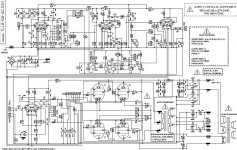A friend told me his volume level was really low, although the volume pot was fully CW in all three channels, in comparison to what it sounded before!
I thought it was the tubes and a little tweaking with the bias should fix the problem... Better think again...
The sound was still low in volume level in all three channels!
I believe the problem is the output transformer and then I check carefully inside and see R24, 10K/1W placed on the anode of V2 & R63, 4K7/1W placed at the screen grids of the power tubes got burned!
I replaced them with new ones and tried again!
Ha-ha, the R24 burned to the ground again while the R63 got this brown colour like she was sunbathing!
All the other resistors in the anode supplies are in really good shape!
Might V2 be bad? Then why does R63 get burned?
Might C23 & C15 caps or the C22 & C20 is bad? All of them are in really good shape, outside looking of course! I don't have a capacitance meter so I guess I should change them anyway...
But then again, why is R63 burning up? Should I check/replace the C33 cap? But if R63 is allowing excessive current to pass why not all of the anode resistors burn?
I thought it was the tubes and a little tweaking with the bias should fix the problem... Better think again...
The sound was still low in volume level in all three channels!
I believe the problem is the output transformer and then I check carefully inside and see R24, 10K/1W placed on the anode of V2 & R63, 4K7/1W placed at the screen grids of the power tubes got burned!
I replaced them with new ones and tried again!
Ha-ha, the R24 burned to the ground again while the R63 got this brown colour like she was sunbathing!
All the other resistors in the anode supplies are in really good shape!
Might V2 be bad? Then why does R63 get burned?
Might C23 & C15 caps or the C22 & C20 is bad? All of them are in really good shape, outside looking of course! I don't have a capacitance meter so I guess I should change them anyway...
But then again, why is R63 burning up? Should I check/replace the C33 cap? But if R63 is allowing excessive current to pass why not all of the anode resistors burn?
Attachments
First, test the output transformer. The dc resistance of each half primary (anode to +CT) should be 20 to 40Ohms on a Marshall. Then test for shorted primary sections (a frequent failure in Marshalls), by getting some old 12Vac adapter (make sure it's not dc!) or mains trafo.
Disconnect the mains plug! Remove the output valves. Connect the 12Vac to the two anode terminals on the OTX - measure the Vac on the speaker side of the trafo - should be about 1/30 x the input voltage. Next, connect the 12Vac to the 8 ohm speaker output terminals, and measure the voltage (ac) at the anodes - should be about 25 to 30 x the input Vac ~(460Vac).
The screen grid resistors will blow because
- The output valves are destroyed
- OR there is no anode voltage (transformer open circuit - easy to test!) in this case the screen act like an anode and take MUCH too much current
R63 will blow because of short in C33 or failure in V3.
Remember that Marshalls run hot, especially in hot Athens! In this case all the power supply capacitors should be changed, maybe every 7 to 10 years.
I would not put the power on it again without new caps, especially C33. And they sound much better for a recap anyway.
Panasonic TSUP and TSHA/HB/HC work very well in Marshalls, or find some Nichicon standard series. Use the same capcitance values as before, 350V or 400V rated.
Disconnect the mains plug! Remove the output valves. Connect the 12Vac to the two anode terminals on the OTX - measure the Vac on the speaker side of the trafo - should be about 1/30 x the input voltage. Next, connect the 12Vac to the 8 ohm speaker output terminals, and measure the voltage (ac) at the anodes - should be about 25 to 30 x the input Vac ~(460Vac).
The screen grid resistors will blow because
- The output valves are destroyed
- OR there is no anode voltage (transformer open circuit - easy to test!) in this case the screen act like an anode and take MUCH too much current
R63 will blow because of short in C33 or failure in V3.
Remember that Marshalls run hot, especially in hot Athens! In this case all the power supply capacitors should be changed, maybe every 7 to 10 years.
I would not put the power on it again without new caps, especially C33. And they sound much better for a recap anyway.
Panasonic TSUP and TSHA/HB/HC work very well in Marshalls, or find some Nichicon standard series. Use the same capcitance values as before, 350V or 400V rated.
- Status
- Not open for further replies.
